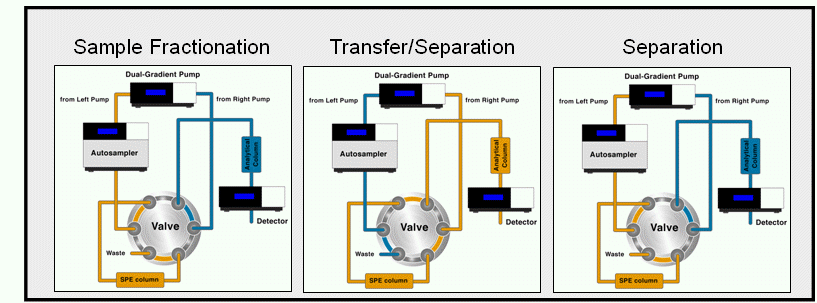
On-Line SPE-LC (On-Line Solid Phase Extraction Combined with Liquid Chromatography)
On-line Solid Phase Extraction combined with liquid chromatography (LC) is an automated extraction and analysis process for fluid samples. The analyte is directly enriched and analyzed in the chromatographical system. Whereas conventional HPLC methods require several manual preparatory steps to eliminate the sample matrix, on-line SPE-LC enhances the sample throughput while improving the overall analytical quality.
One of the possible setups for an analytical system includes a small dedicated SPE column and an analytical column, coupled via a 2-position switching valve (either 2-position 6-port or 2-position 10-port valve). The target analytes are selectively extracted from the matrix (integrated sample cleanup) and pre-concentrated. The trapped analytes are transferred in backflush mode to a conventional analytical HPLC column for analyte separation and detection. During this step, the SPE column can be reconditioned.

The figure shows a typical setup of an On-line SPE-LC system with a 2-position 6-port switching valve. In the sample fractionation step, the analytes are trapped on an SPE column while the matrix is flushed to waste. In the second step the analytes are transferred to the analytical column. An UltiMate 3000 x2 Dual-Gradient system integrates two pumps in one enclosure and provides a preinstalled thermostatted switching valve.
The application of column-switching for extractive sample clean-up and analysis involves four steps:
1. Matrix depletion and analyte extraction
The sample is loaded with a mobile phase delivered by one of the two pumps via an autosampler onto the SPE column . While the sample matrix is flushed to waste, the analytes are retained on the SPE column.
2. Analyte transfer from the SPE column to the analytical column
After the sample matrix has been eluted from the SPE-column, the valve is switched into a position where the flow direction changes (Backflush Mode) and the SPE column is coupled with the analytical LC column. The composition of the mobile phase delivered by the second HPLC pump is chosen in such a way that it desorbs the analyte(s) from the SPE column.
3. Analyte separation
After the transfer of the analyte(s) onto the analytical LC column, the valve is switched back into its original position. Separation of the analyte(s) from each other is achieved on the analytical column in the conventional manner (isocratic or gradient elution mode).
4. Reconditioning of the SPE column and re-equilibration of the analytical column
During the analytical separation, the SPE column can be washed and re-equilibrated with mobile phase delivered by the pump connected to the autosampler. This procedure eliminates carryover and at the same time retains full capacity of the SPE column. The analytical column is re-equilibrated during the analytical run.
System Requirements for On-Line SPE-LC
When performing On-Line SPE-LC using a Dionex UltiMate 3000 system, the instrument setup should be as follows:
one TCC-3x00RS/SD, TCC-3100 or TCC-3200 comprising at least one 2-position switching valve (either 2-position 6-port or 2-position 10-port valve)
one WPS-3000SL, WPS-3000RS, WPS-3000TXRS or WPS-3000 TBPL Analytical (Note: the sampler must not be shared by 2 timebases)
two UltiMate 3000 pumps (either isocratic and/or gradient pump)